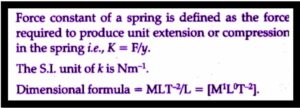Table of Contents
Dimensions of Force Constant: A force constant, as defined by Hooke’s law, is another term for a spring constant in physics. More exactly, it is a proportionality constant. The rigidity (or stiffness) of a system is connected to its strength constant k; the higher the force constant, the greater the regained force, and the harder the system.
According to Hooke’s law, the force required to extend or compress a spring by a certain distance is proportionate to that distance. The spring’s stiffness is a consistent property. The elastic property indicates that stretching a spring twice as long requires twice the force.
A Brief Outline
Consider a bond and its constituent atoms to be a spring with two associated masses. The equation then illustrates how the absorption frequency, u, can change when the system’s characteristics change, using the force constant k (representing the spring stiffness) and the two masses m1 and m2.
Important Concepts
If the spring constant is 0, the stiffness of the spring is also zero. There would be no force acting in the opposite direction, hence it will no longer be regarded as a spring.
If the spring constant is negative, it means that the spring will always act in the direction of displacement rather than exerting an equal and opposite force.
Dimensional Formula of Force Constant
The dimensional formula of force constant is:
[M1 L0 T-2]
M = Mass, L = Length, T = Time
Derivation
Force Constant= Force × [Displacement]-1 – 1
Meanwhile, Force = m × a
So, the dimensions of force = [M1 L1 T-2] – 2
The dimensional formula of displacement = [M0 L1 T0] – 3
On replacing equation (2) and (3) in equation (1)
Force Constant= Force × [Displacement]-1
= [M1 L1 T-2] × [M0 L1 T0]-1 = [M1 L0 T-2].
Hence, the force constant is dimensionally represented as [M1 L0 T-2].

Significance of dimensions of force constant in IIT JEE exam
It is critical to take a holistic approach to every facet of a subject’s chapter. It will not only adequately prepare you for the exam, but will also clarify your understanding of each topic. It will help you pass the JEE exam’s conceptual problems. The number of questions from the chapter unit and dimensions would be one or two, with a weightage of roughly four marks.
FAQs
A constant force spring is one that applies the same force throughout its range of motion. Hooke's law does not apply to the constant force spring. Constant force springs are typically made from a wrapped ribbon of spring steel with the string resting when it is fully coiled up.
A force constant, as defined by Hooke's law, is another term for a spring constant in physics. More exactly, it is a proportionality constant.
In molecular systems, the magnitude of the force constant k is determined by the type of the chemical bond, just as it is determined by the nature of the spring in mechanical systems. The firmer the spring or the stronger the bond, the bigger the force constant. What is the definition of a Constant Force Spring?
What is the meaning of the force constant?
What factors influence the force constant?



